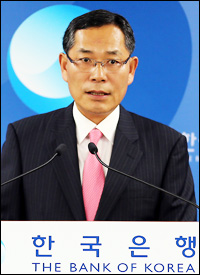
Sharp pullback in growth
GDP expands at slowest pace since 3rd quarter of 2009

Korea’s growth has slowed to its lowest rate since the depths of the global financial crisis, raising investor concerns that the economy has yet to bottom out and more policy action will be needed to halt the skid.
The Korean economy grew at an annualized 2.3 percent in the second quarter, less than the 2.4 percent first thought, representing the slowest pace since the 1 percent expansion in the third quarter of 2009, the Bank of Korea (BOK) said Thursday.
Quarter-on-quarter growth was measured at 0.3 percent, down from the bank’s preliminary estimate of 0.4 percent and a third of the 0.9 percent growth measured in the first three months of the year.
Worsening global conditions, highlighted by the debt crisis in Europe, faltering U.S. recovery and a slowing China, have compromised Korea’s strength in exports, its main growth engine. Consumers can’t pick up the slack when stagnant income, unemployment and historically high household debt have family finances decaying faster than fish guts.
The bad data all but ensures that the central bank will show more aggression in jolting money supply in coming months.
Interest-rate setters at the BOK ended a 13-month holding streak in July to lower the policy rate by 0.25 point to 3 percent and it’s widely expected that borrowing costs will be reduced further soon and as early as this month. Oh Suk-tae, a senior economist at SC First Bank, predicts the BOK will take an additional 0.5 point off interest rates by the end of the year.
However, easing monetary policy, and thus extending the expectations for cheap borrowing, would be an uncomfortable move in a country where the household debt mountain, at around one quadrillion won, matches the size of an entire year’s GDP.
Jung Yung-taek, head of the BOK’s national accounts division, admitted there was little reason to think that the third-quarter growth figures will look less ugly.
“When we made the preliminary estimates (in July), we were unable to take the June data fully into account and the figures for that month were bad. The pace of growth in the industries of construction and manufacturing were also worse than we previously thought,’’ Jung told reporters.
“The real economic indicators for July don’t appear to be inspiring and it’s hard to imagine that things did or will pick up significantly in August and September.’’
The BOK had earlier forecast quarterly growth to measure around 1 percent in the third and fourth quarters, allowing the country to manage an annual 3 percent expansion. That is looking more like prayer than preview now as most analysts project annual growth to fall into the 2 percent range.
Exports contracted 1.4 percent in the April-June period from the first three months of the year and imports also shrank by 1.8 percent, pointing to an all-around regression in outbound shipments, domestic demand and business investment.
Consumption rose slightly at 0.4 percent in the second quarter from the first but was down from the previous estimate of 0.5 percent. Facility investment fell 7 percent, compared with a 6.4 percent contraction and construction investment fell 0.4 percent, a reversal from an earlier estimate of a 0.3 percent gain.
The manufacturing sector contracted by 0.2 percent quarter-on-quarter, a sharp reversal from the 2 percent growth posted in the first quarter, owing to softening activity in the electronics, energy and chemicals sectors. The construction industry contracted by 2.7 percent, as builders continued to be exposed to the toxic property market, while the service sector managed a modest 0.2 percent expansion. <The Korea Times/Kim Tong-hyung>




